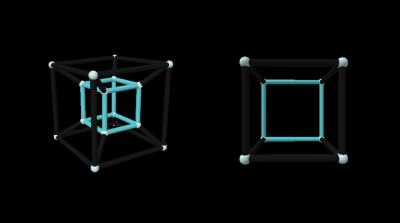Why is understanding hyperspace important?
Time is often considered the fourth dimension, and yes, it is a construct that exists. The fourth dimension in question here specifically refers to a fourth
spacial dimension, a fourth direction. So now that we're all on the same page, fasten your seatbelts and let's punch it to 60 in second gear.
Understanding hyperspace broadens our capacity for thinking and is a necessary component in our conscious evolution. Learning and practicing mathematics has always concerned increasing our capacity for problem solving, and understanding 4D+ space is no different. With it, we can imagine and create new things.
As far as we know, hyperspace only exists in software and our minds. Learning how to perceive four dimensions is a concrete feature of thought as opposed to an abstract concept. We are rapidly moving towards a future of augmented reality and
transhumanism that will allow us to interact, perceive, and think directly in cyberspace. 4D systems will no doubt play a role in some future developments, even if it is not a property of physical existence as we know it.
Reddit Graveyards

Be sure to occasionally check out
r/FourthDimension for other peoples' thoughts, reasoning, and resources regarding 4D space.
Also look at
r/hypershape for some interesting and rare visualizations. This board has been dead for two years, but at the same time has an outstanding history of posts.
Interactive 4D Handbook
 Bailey Snyder
Bailey Snyder
has developed the most easily comprehendible explanation of 4D Space there is. Even if you already think you understand 4D space pretty well, checking out his
interactive demonstration
of the dimensions is highly encouraged. It covers just about everything and leaves nothing to the imagination.
4D Toys
4D Toys is an interactive software that is one of the best visual representations for conceptualizing how 4D objects interact, taking into account momentum and rotation. It is available on
Steam and
Apple App Store.
Hoxeldraw
An online user going only by the alias Doctor Hoxel has developed a unique 4D software for pixel art. It uses cross section and slice grid displays which allows the object of one's creation to be seen fairly easily. It has clear 3D and 4D rotation controls. The two displays are side by side, and both are interactive, with a corresponding highlight from the hover position of the one in use. It is available on
GitHub.
Even if it draws a relation between their natures, seeing four-dimensional space only as a linear set of separate parallel 3D realities renders the concept of it meaningless, since the 3D worlds would not interact.
Hypercube Demo
Albert Hwang's Hypercube Demo is an interactive virtual reality software which allows the user to rotate a hypercube in 3D space. He explains very well in the video how intuitive handling it becomes and how it's nature can be seen.
Miegakure
Miegakure is an RPG puzzle game in which one moves freely throughout a four-dimensional world to try to get from point A to point B. The name is Japanese for "in and out of sight" and it is advertised as a "hide and reveal" game. It is available on
Steam.
4D Explorer
Jelle Vermandere has developed a simpler RPG game similar to Miegakure, which he credits, with different permissible properties, which is free to play on his
website. In the above video, he explains how the software functions.
4D Miner
4D Miner is a Minecraft clone and survival game, which since it is also interactive would make it one of the better candidates for understanding operations in hyperspace. It is available on
Steam.
Bluecore97 has asserted that 4D space is purely 4D without 3D spaces existing independently within it, the same way that 1D and 2D do not truly exist in our 3D world.
4D Golf
CodeParade has developed a golfing puzzle game which allows the player to hit the ball and then maneuver through four dimensions as it moves. This is a great resource for working on reaction time while understanding 4D space. It is available on
Steam.
And earlier in 2025, the YouTube user
RAMDER+ released a spoiler for 4D golf having two final 5D levels. RAMDER+ very intuitively explains the first four dimensions, showcasing visuals from 4D Miner, 4D Golf, and others to get the point across, then stammers through the 5D levels while giving instruction on how to beat them.
4D Minesweeper

Julian Schlüntz has developed an extension to the classic Minesweeper with the same logic and similar 2D display applied to four dimensions. Although this would seem to be a burden, the display with hover highlights is helpful. It is available on
Steam.
Tesseract!
A ball-in-a-maze puzzle game in 4D instead of 2D created by
Anthony Grahn, who gives a breakdown of the game mechanics on his website as well as another on the
game website. The navigational setting is in 3D rooms of a hypercube with other 3D rooms visible around the one with the ball, which results in a simplified perceptual 3D setting. It is available in the
Apple App Store.
4D Maze
John McIntosh has developed a way to see and navigate four dimensions using colors of lines to indicate directions. While it looks to be difficult at first, it has been shown that people develop an understanding of it within minutes.
Cake4D
Cake4D is another maze game published by a new developer called TAP OK G, but from a 3rd person RPG approach, with a surprisingly good feel on the graphics for what it is. Like Miegakure, the player is viewing 3D slice of a 4D world and transitioning between slices, solving some form of puzzle to get to the next area. Like Portal, the player is also looking for a cake. It is available on
Steam.
4D Snake
Developed by GJ The Game Dev. its unique display and controls offer a different perspective, which may be helpful or unhelpful to players depending on their preferences; the interface is two D-pads. It is exactly like 2D Snake, just with four dimensions. It is available on
GJ The Game Dev's itch.io and
Google Play.
Magic Cube 4D
The 4D Rubik's cube works surprisingly similar to the 3D cube, just with slightly more connections in its hyperspace divisions. By now you have figured out how a hypercube turns, and the Rubik's cube twists in the same fashion. While solving is not the easiest task, taking a moment to understand its rotation offers some insight thus far not covered. It is available on
Google Play.
Magic Cube 4D VR
Another version of with Magic Cube 4D by a different developer simply known as Magic Cube 4D VR, only this one has a hands-on interface. Weirdly, all information about it as well as the game itself is only available on
Steam.
Imagining the 10th Dimension is not how the dimensions of string theories (hypotheses) actually work. In string theories, now long consolidated into M-theory (hypothesis), the extra dimensions fold in on themselves to a point at every point of 3D space, not acting as a directional space like we perceive. Rob Bryanton connects many dots from several different concepts that don't actually connect. While the book/video may be useful for visualizing dimensions to some, nothing in them should be taken as fact or as an accurate reflection of any existing models.
Quaternions
For those of you familiar with how the complex number system works, you know that the nature of addition and multiplication is purely rotational. Quaternions are numbers with one real and three imaginary components. Pure imaginary quaternions perfectly describe 3D rotation in real space as in the video above. However, when it is
projected onto 3D real space from a rotation in 4D space, something very different happens in an object's rotation than what has been shown so far.
CG Cookie explains this as well as gives a visual.



